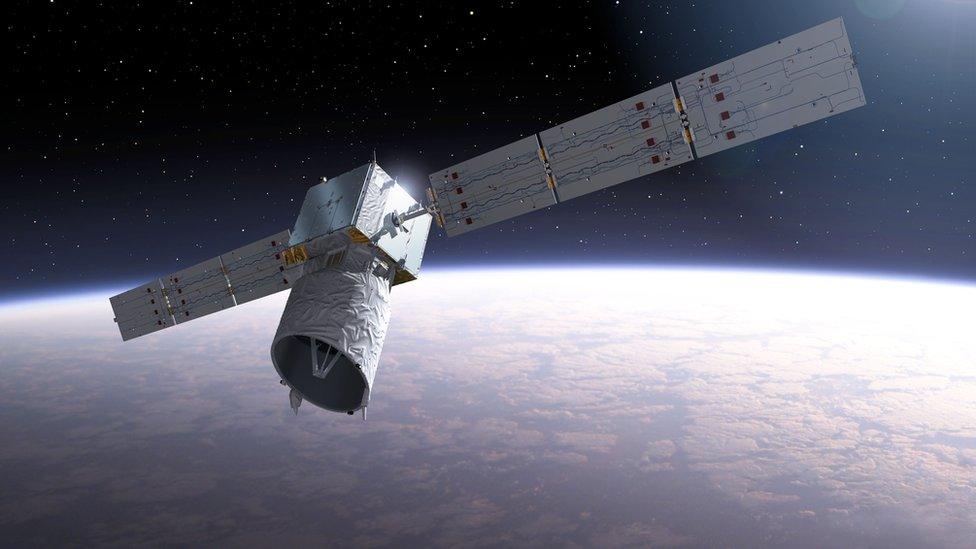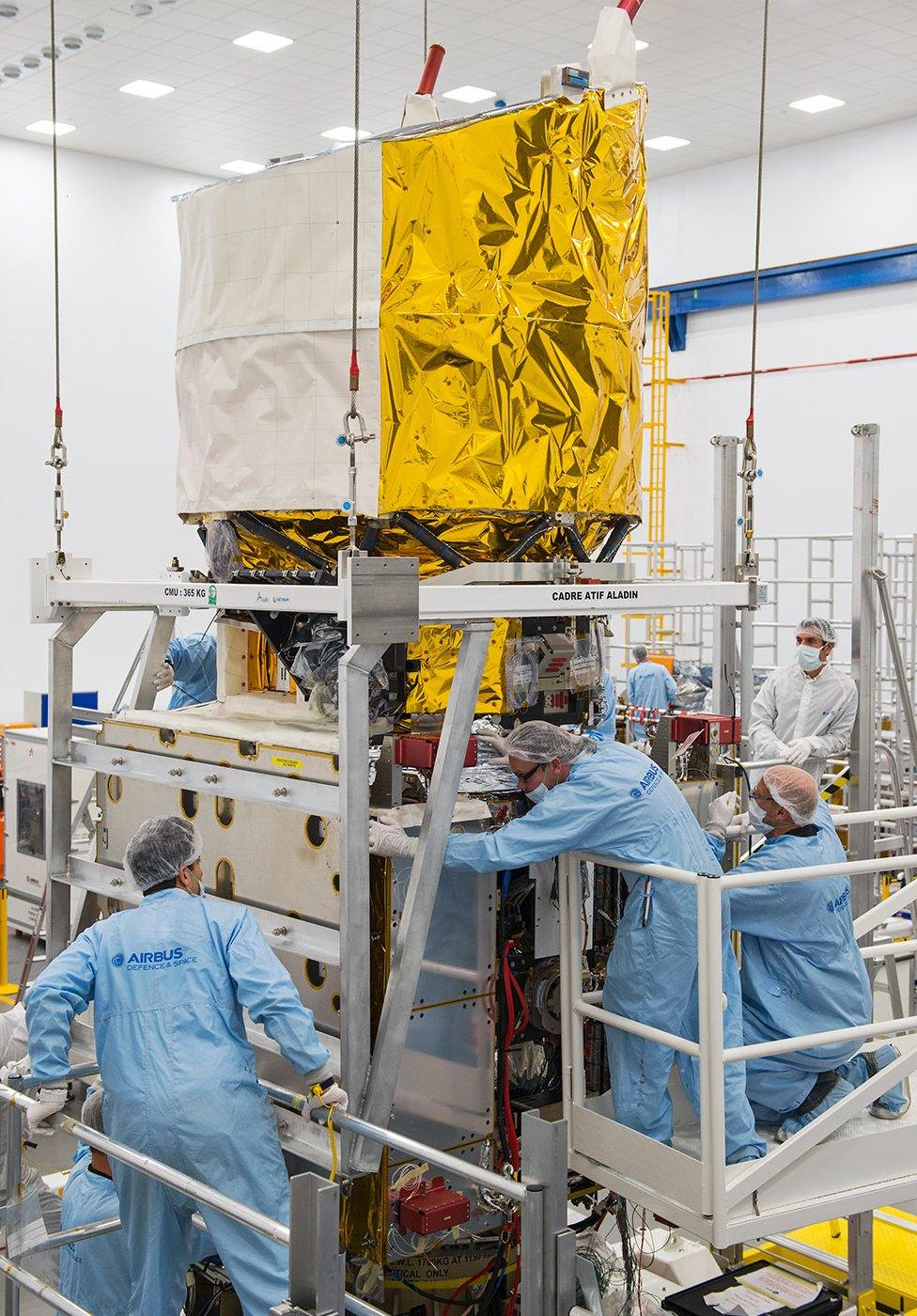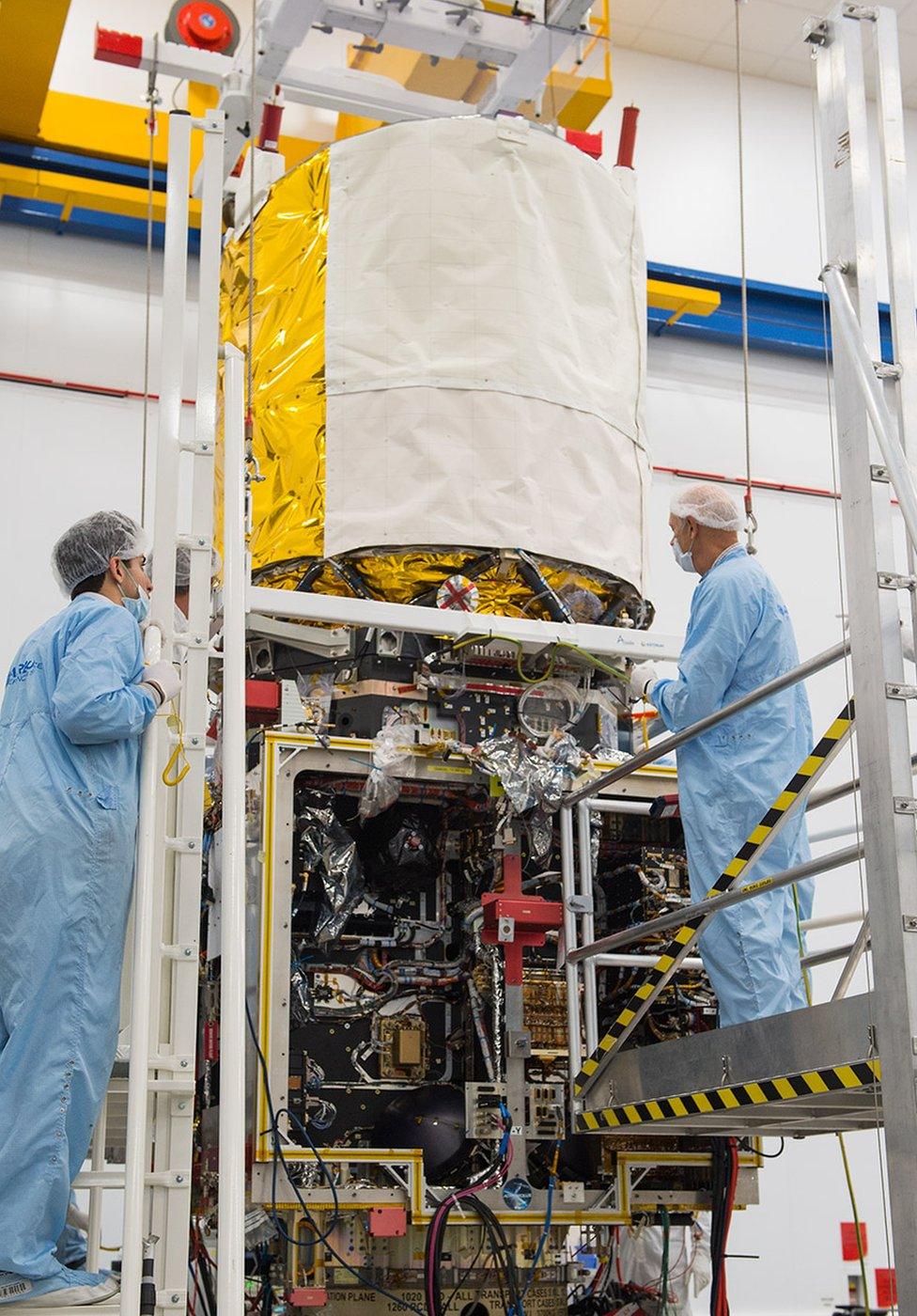Aeolus space laser catches a following wind
- Published

The mission's full name is Atmospheric Dynamics Mission (ADM-Aeolus)
Europe’s Aeolus space laser mission, which is designed to make unprecedented maps of Earth’s winds, has reached a long-awaited key milestone.
Engineers at Airbus in the UK, external have finally managed to bolt together all the elements of the satellite after overcoming major technical challenges.
Aeolus, external is now set for several months of testing before being sent into orbit next year.
That will be 10 years on from the originally envisaged launch date.
“It’s been a long time coming but it’s a hugely important mission,” said Dr Ralph Cordey from Airbus.
“Operating lasers in space is not easy, but I’m pleased we’ve persevered with this technology in Europe because it has many potential applications, not just in measuring the wind."
The European Space Agency (Esa) has stuck with the project because of the nature of the data it will return.
It promises to give a big fillip to weather forecasting. Even with the delays to the programme, the meteorological agencies still regard its information as a priority, external.

Key milestone: The Aladin instrument and its telescope are lowered on to the satellite bus
Aeolus carries a laser instrument (lidar), called Aladin, that will probe down through the atmosphere to see the altitude of wind streams and gather some information on their speed and direction.
Today, we have multiple ways of measuring the wind, from whirling anemometers and balloons to satellites that infer wind behaviour by tracking cloud movement or sensing the choppiness of the seas.
But these are somewhat limited indications, telling us what is happening in particular places or at particular heights.
Aeolus, on the other hand, will attempt to build a truly global, multi-layered view of wind behaviour on Earth, from the surface of the planet all the way up through the troposphere into the stratosphere (from 0km to 30km).
The models used to forecast tomorrow’s weather will clearly benefit from this, but so too will the simulations that investigate future climate scenarios.

Aeolus will map the winds from an altitude of 400km
Circling the globe, the satellite’s ultraviolet beam will pulse the air below it.
The time taken for the light to scatter back off molecules, dust and moisture particles will reveal where the big wind streams are in the atmosphere.
Small shifts in the frequency of the light will say something about the speed and direction those various markers - and the winds that carry them - are moving.
Aeolus actually only sees the movement of the scattering particles away or towards the satellite - but this is still information the numerical weather models can make great use of.
The concept is well established. Lasers like this are routinely fired into the sky from the ground to retrieve similar data at a single location.
The difficulty for the Aeolus team has been in developing an instrument that will work in space. Esa approved the mission back in 1999 and contracted industry to start building it in 2003, external. That’s when the trouble started.
Installing a flush
The first problem was in finding diodes to generate a laser source with a long enough lifetime to make the mission worthwhile.
With that fixed, the mission looked in great shape until engineers discovered their laser system could not work in a vacuum - a significant barrier for a space mission. Tests revealed that in the absence of air, the laser was degrading its own optics.

Tests revealed the surfaces of the optics were becoming contaminated
“Inside the instrument there are over 100 optical surfaces - lenses and mirrors to prepare the laser beam - and they were becoming contaminated,” explained Aeolus Airbus project manager Richard Wimmer.
“There were two sources of contamination. If there were particles on the optical surfaces, the laser would burn them and blacken the surfaces. But the laser was also dragging particles on to the surfaces that were outgassing from the spacecraft.”
The solution was to introduce a means to flush Aladin with oxygen at a very gentle rate. Its implementation has, of course, elongated the programme and added significant extra cost.
What was supposed to have been a €300m mission is now estimated at €450m.
'We'll be ready'
For many years, I would pass through the Airbus cleanroom in Stevenage and see the spacecraft bus - that part of the satellite which holds its computers, avionics, fuel tanks, and the like - sitting idly in the corner, waiting on experts in Italy (Leonardo) and France (Airbus) to solve the instrument issues.
But on Thursday, the British engineers were finally able to lower a completed Aladin laser instrument - together with the telescope it will use to spy the scattered light signal - on to the rest of the satellite.

A successful Aeolus mission opens up other space laser possibilities
The spacecraft must now undergo a series of tests prior to riding its Vega rocket into orbit next year.
Richard Wimmer has stayed with Aeolus throughout its trials and tribulations and was clearly delighted to see the full satellite come together.
“It’s one of those bizarre things where you wait and wait and wait, and then it comes and it seems like just another event. But it’s a major milestone for sure because now we’re on a more standard assembly, integration and testing sequence.
“We’ve got one very important and complex procedure to do in Liège in Belgium, where as well as putting the satellite in a thermal vacuum chamber we’ll also operate the whole instrument system and measure its performance. Then we’ll be ready.”
For Europe, Aeolus is an important step. The hard lessons learned are being applied to the next Esa laser mission called Earthcare, which will study the role clouds and atmospheric particles play in a changing climate.
But having this technology opens up other possibilities as well, such as making very precise surface height measurements. The Americans, for example, have done this with ice sheets and forest canopies.

A period of testing will now be undertaken before the launch to orbit in 2017